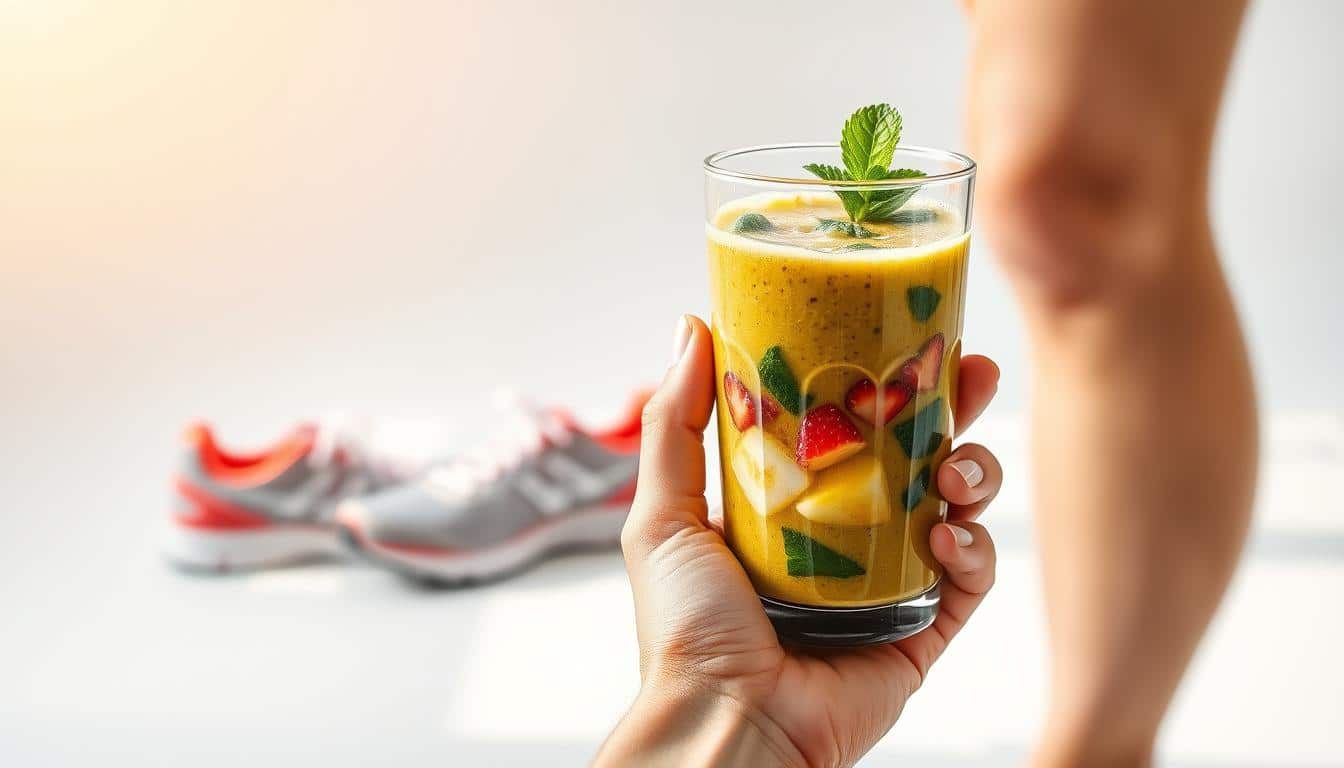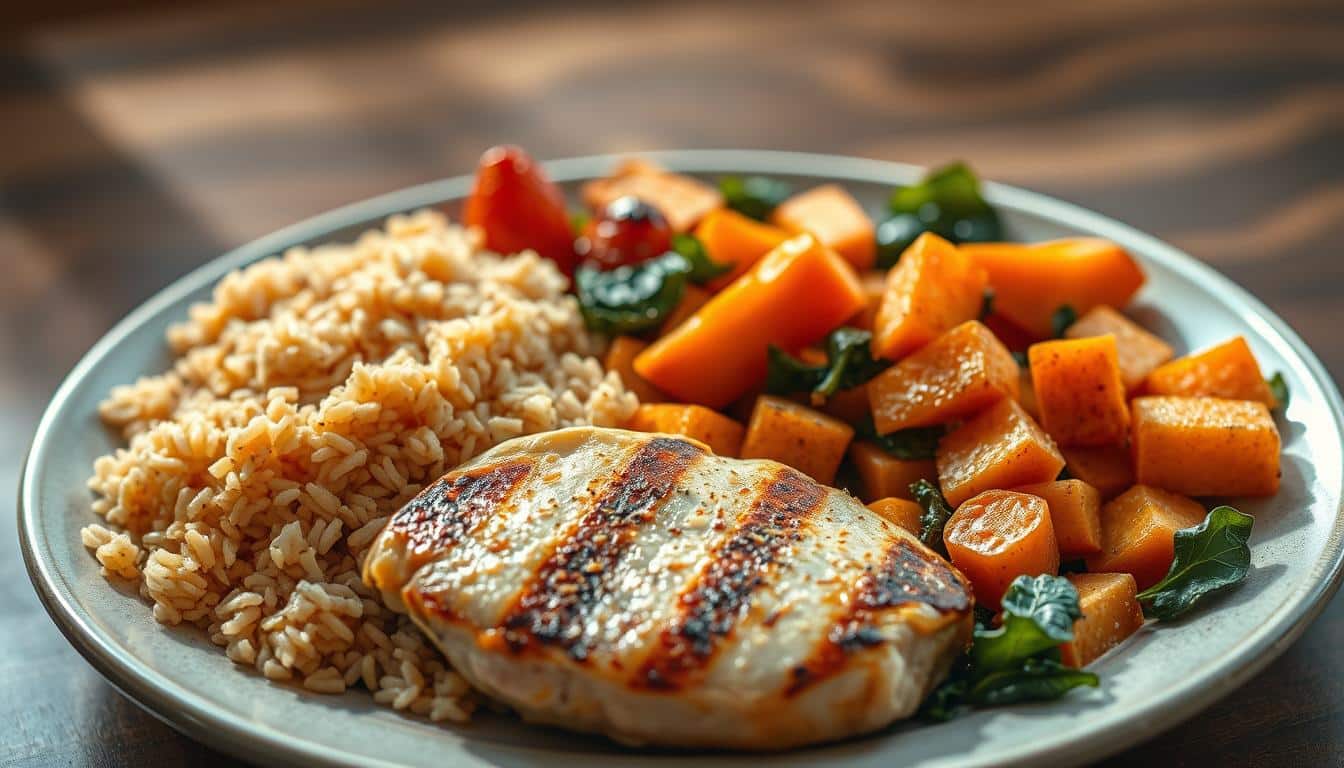Surprising fact: you burn up to 80% more glycogen on high‑intensity runs than on easy miles. That loss shapes how you eat and how you feel each day.
We give you a simple, real-world approach you can use during training. You get a step‑by‑step framework that matches calories to work. This keeps energy steady and stops low energy levels.
You’ll use simple carbs for quick fuel and complex carbs in main meals. You’ll add protein at each meal to speed recovery. Healthy fats support hormones and easy days without slowing your stomach.
Hydration is clear and easy: drink so your urine stays light yellow. Practice this in training so nothing surprises you on race day. Read on and you’ll have one clear, flexible routine to fuel your body and recover well.
Set your nutrition goals for marathon training
Match what you eat to your weekly training load. Your calorie needs rise with mileage, pace, and duration. Set a clear calorie target that reflects your training and your body goals.

Match calorie intake to training load and body goals
Raise or lower calories based on your weekly runs and how you feel during the day. If weight loss is a goal, reduce portions slowly. Track mood, hunger, and pace to see if targets work.
Balance carbs, protein, and fats for steady energy levels
Build each meal with carbohydrates, protein, and fats. Many runners do well with three meals and two to four snacks spaced through the day. Space protein about every three hours in ~20 g doses to speed recovery and steady appetite.
- Adjust carbohydrates up on hard training days and down on rest days.
- Keep breakfast simple on busy mornings to start energy early.
- Review the plan weekly and make small changes based on how your body responds.
diet plan for marathon runners: core principles
Good fueling follows a few clear rules you can use every training day. Keep choices simple and repeatable so you can track what works.

Use simple carbs before, during, and after runs
Simple carbohydrates are fast sugars that give quick energy. Eat bananas, white toast, rice cakes, gels, or sports drinks before or during hard sessions.
Use the same simple carbs right after a workout to speed recovery and refill energy stores.
Build main meals with complex carbs
Complex carbohydrates digest slowly and steady energy over the day. Choose oats, brown rice, quinoa, beans, lentils, and sweet potato in main meals.
Include lean protein at each meal
Protein helps muscle repair and recovery. Aim for about 20 grams every three hours.
Good sources are chicken, fish, eggs, yogurt, tofu, and beans.
Add healthy fats wisely
Fats support hormones and vitamin absorption. Use olive oil, avocado, nuts, and seeds.
Keep fats lower right before a run so your stomach feels light.
- Plan a small snack with simple carbohydrates if you train early or feel low energy.
- Build meals around complex carbs + protein, then add moderate fats.
| Timing | What to eat | Why |
|---|---|---|
| Pre-run (30–60 min) | Banana, rice cake, half bagel | Quick fuel that sits light |
| Main meal | Oats or brown rice + chicken or beans | Refills glycogen and supports muscle |
| Post-run (within 60 min) | Yogurt + fruit or recovery shake | Carbs + ~20 g protein for recovery |
| Low-intensity days | Whole grains, legumes, nuts | Steady energy, hormone support |
Plan your day: meals and snacks that fuel your runs
Plan your meals and snacks so your energy stays steady from morning runs to evening rest. Use simple, repeatable foods you like. Small changes each day beat big surprises on key training sessions.
Breakfast ideas
Build a fast breakfast you can eat after a run: oats with yogurt and berries, eggs with toast, or toast with peanut butter. Breakfast after morning runs supports recovery and refills glycogen quickly.
Lunch ideas
Pack lunch bowls with rice or pasta, chicken or tofu, beans, and plenty of veggies. Beans and lentils add protein, carbs, and fiber for steady energy through the afternoon.
Dinner ideas
Rotate dinners: salmon or turkey with sweet potato and a big salad. Keep fats moderate before bed so your body digests well and recovers overnight.
Smart snacks
Keep snacks simple and practical. Try a banana with almonds, yogurt with fruit, or hummus and veggies. These slow sugar spikes and keep your body fueled between meals.
- Use rice or pasta as the main carb on hard training days.
- Add beans to lunch for extra fiber and lasting fullness.
- Plan meals the night before to keep your day on track and energy steady.
| Time | Quick option | Why |
|---|---|---|
| Post-run breakfast | Oats + yogurt | Refills glycogen and adds protein |
| Lunch | Rice/pasta bowl with chicken | Steady carbs and muscle repair |
| Snack | Banana + nuts | Quick carbs + healthy fats to slow sugar |
Fuel long runs and race day: timing, amounts, and options
Start fueling smartly during long efforts so energy and focus stay steady. Begin after the first hour and use clear time cues you can follow when the miles add up.
Target about 30–60 grams of carbohydrates every 30–45 minutes. That keeps steady energy and helps you avoid the wall. Your stomach can absorb roughly 60 grams per hour when you drink with carbs.
- Choose energy gels, chews, sports drinks, or easy fruit you’ve tested.
- Chase concentrated gels and chews with water to dilute sugar and lower GI risk.
- Alternate water and a sports drink at aid stations if you need electrolytes and carbs.
- Bring enough fuel for the hours you expect to be on course and practice this on long runs.
- Use rice-based cakes or soft chews if gels irritate your stomach.
| When | Amount | Options |
|---|---|---|
| After 1 hour | 30 g every 30–45 minutes | Gel + water, soft chew, banana |
| Per hour max | Up to 60 g carbohydrates | Alternate water and sports drink |
| Hot or fast effort | Shorten to 25–30 minutes | Smaller doses, extra water |
Hydration and electrolytes for training and the marathon
How you drink across a training day can make a big difference in energy and comfort on long runs.
Drink to thirst and check that your urine stays light yellow during the day. That simple check tells you whether your body needs more fluids or is well balanced.
Alternate water and sports drinks on long efforts
On long runs, swap bottles: one with water, one with a sports drink. That covers plain fluid and the sodium you lose in sweat. Sip small, steady amounts rather than big gulps to avoid stomach trouble.
Make a DIY sports drink
Mix three parts diluted fruit juice to one part water and add a pinch of salt. This gives you carbs and sodium without fancy products. Carry it on long run practice to see how your body reacts.
- Increase fluids when heat and humidity rise during training.
- Sip water with midrun fuel to help absorption and reduce GI issues.
- Keep fats lower near hard sessions so hydration and digestion stay fast.
- Add a salty snack after long efforts to aid recovery.
- Refill bottles at regular course points and log your sweat response to fine‑tune future days.
| When | What | Why |
|---|---|---|
| Daily | Water + light checks | Maintain hydration levels |
| Long run | Alternate water & sports drinks | Replace fluids and electrolytes |
| Post long run | Snack with salt | Speed recovery and restore balance |
Macros that work for runners
Think of macros as the tools that keep your energy steady during training. Use a simple structure and tweak it as your weekly load changes.
Carbs as primary fuel
Carbohydrates are your main fuel for hard sessions and glycogen reloading. Raise carbs on heavy training days and lower them slightly on easy days.
Protein spacing
Spread protein evenly throughout the day. Aim for ~20 g every ~3 hours to support muscle repair and steady recovery.
Fats and recovery
Keep fats steady to support hormones and absorb vitamins A, D, E, and K. Choose olive oil, avocado, nuts, seeds, or salmon.
- Start with a simple split: higher carbs, moderate protein, modest fats.
- Add an extra meal or shake in peak weeks to protect muscle.
- Use a meal template: carb base + lean protein + colorful veggies + healthy fat.
- Track energy and sleep to see if macro tweaks improve performance.
| Macro | Action | Example |
|---|---|---|
| Carbohydrates | Primary fuel; raise on hard days | Rice, oats, potato |
| Protein | ~20 g every ~3 hours | Greek yogurt, chicken, tofu |
| Fats | Keep steady; support vitamins | Olive oil, avocado, nuts |
Race week and pre-race meals
In the days before your big run, food becomes a tool to top up energy and calm the gut. Keep choices simple and repeat what worked during training. Focus on high carbohydrates, moderate protein, and low fat and fiber.
What to eat in the last 48–72 hours
Plan the last two to three meals to be high in carbohydrates with moderate protein. That helps refill glycogen without upsetting digestion.
Evening and pre-race dinner
Choose easy-to-digest dishes like pasta or rice with chicken and a light salad. Keep sauces mild and fats low so your stomach stays calm.
Prerace breakfast
Eat breakfast you’ve tested during training. A bagel with peanut butter and a banana is a reliable choice that gives carbs and a touch of protein.
- Time your last full meal 3–4 hours before the start.
- Have a small snack 60–90 minutes before if you need extra fuel.
- Keep eggs or yogurt earlier in the week if they sit well with you.
- Avoid new foods, heavy sauces, or high-fiber dishes that can raise GI risk.
- Sip water and small amounts of sports drink when you need electrolytes.
| Timing | Example | Why |
|---|---|---|
| 72–48 hours out | Pasta + chicken, rice bowls, yogurt | High carbohydrates, moderate protein, easy digestion |
| Night before | Pasta with light sauce + salad | Top up glycogen and avoid heavy fats |
| Race morning (3–4 hrs) | Bagel with peanut butter + banana | Quick carbs, small protein to steady energy |
| 1 hr before | Small banana or rice cake | Light fuel without upsetting stomach |
Recover right after runs and hard workouts
A focused recovery snack in the first hour speeds repair and steadies energy later in the day. Aim to eat within 30–60 minutes after a run or hard training session. That window helps you refill glycogen and support muscle recovery quickly.
Target 15–30 grams of protein plus carbohydrates at a 3:1 or 4:1 carb-to-protein ratio. Use 0.6–1.0 g/kg of carbohydrates within 30 minutes, then repeat a similar dose every two hours for 4–6 hours to rebuild stores.
- Blend a smoothie with Greek yogurt, banana, and berries for a fast recovery meal.
- Try yogurt with fruit, or multigrain toast with nut butter as simple snacks.
- Keep protein spacing steady throughout day to support muscle repair.
- Add a small snack later to keep recovery moving and energy levels stable.
Rehydrate and replace sodium after long runs. Drink water and include a salty snack or sports drink to restore fluid balance and electrolytes. Log how you feel the next day to judge if this recovery approach works for your body.
| When | What | Why |
|---|---|---|
| 30–60 minutes | 15–30 g protein + carbs (3:1 or 4:1) | Speed muscle repair and start glycogen refill |
| Every 2 hours (4–6 hrs) | 0.6–1.0 g/kg carbohydrates | Complete glycogen restoration |
| Post long run | Water + salty snack or sports drink | Restore fluids and sodium lost in sweat |
Conclusion
Finish strong: use simple habits every day to protect energy and speed recovery.
Follow a repeatable approach to meals and snacks so your training stays steady. Build plates with carbohydrates, protein, veggies, and healthy fats. Use proven foods like rice, pasta, chicken, salad, yogurt, eggs, and beans to keep fuel reliable.
Hydrate so your urine stays light yellow and sip water during runs as practiced. Fuel long efforts with 30–60 g carbohydrates per hour and use energy gels you’ve tested. After hard sessions, eat protein and carbs at a 3:1 or 4:1 ratio to help muscle recovery.
Plan one meal and one snack ahead each day to avoid scramble moments. If you want quick breakfast ideas, try this high-energy breakfast resource: boost your day with high-energy breakfasts.
Stay consistent, be kind to your body, and enjoy the marathon you trained for.


